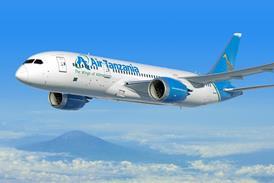The thrust-link issue that forced Boeing to ground its 777-9 test fleet last year was caused by a narrow airflow gap that led to vibration and failure, according to newly available information.
Boeing now says it has addressed the problem with a fix that involves beefing up the thrust links and keeping the components from being struck by air travelling at such high speed.
“The 777-9 team is making improvements to the new airplane’s thrust links to address a vibration that led to cracking of the structural component and temporarily paused flight testing last year,” said a recent Boeing internal message.
Much about the issue had been unknown since Boeing revealed the problem in August last year, saying then that it found a failed thrust link on one of its four 777-9 test aircraft. As a result, Boeing grounded its test fleet. It resumed 777-9 flights in January after a pause that the company also attributes to a workers’ strike last year.

Thrust links transfer thrust from engines to airframes. Each of the 777-9’s two GE Aerospace GE9X turbofans have two thrust links made from titanium.
”At 10 feet long, this is the largest thrust link we’ve ever designed at Boeing, and we found a titanium tube this size can exhibit some unique behaviors,” 777-9 vice-president and chief project engineer Tresha Lacaux said in Boeing’s internal message. “You need the perfect overlapping conditions for this to occur.”
“We have finalised a solution to the 777-9 thrust-link issue identified last year, based on months of rigorous testing and analysis by a team of Boeing experts,” Boeing says. “We have already implemented changes in our flight-test airplanes and will continue to inspect them to ensure continued safe operation.”
“We will adopt further improvements for extended operations and production airplanes prior to first delivery,” the company adds.
Boeing determined that the issue affected left-side thrust links on each of the 777-9’s two GE9X turbofans. Fast-flowing air from a cooling port had caused the thrust links to vibrate, but only when a nearby blanket used to protect hydraulic hoses was within 7.62mm (0.3in) of the thrust links.
“When the blanket was too close to the left thrust link, the narrow gap for airflow led to the thrust link vibrating,” Boeing says.
The company is addressing the issue by adding “straps to secure the blanket to nearby hydraulic tubes” to ensure sufficient separation.
The fix also involves “closing the port directing air at the left thrust link and thickening the thrust link wall by about two-hundredths of an inch,” Boeing adds. “This will eliminate the possibility of a vibratory response.”
Boeing says it still intends to deliver the first 777-9 in 2026.
“The thrust links have performed without issue since we resumed flight testing earlier this year,” says 777-9 deputy chief project engineer Anita Rudack in the internal Boeing message.
“The fourth member of the 777-9 test fleet returned to flight testing this month with the straps around the hydraulic blankets,” the message adds.
It also says Boeing engineers used ”the leaf blowers to simulate high-speed airflow, supporting their hunch on the root cause of the high-frequency vibration”.
Story updated on 28 May to clarify details about the cause of the thrust-link failure.


























